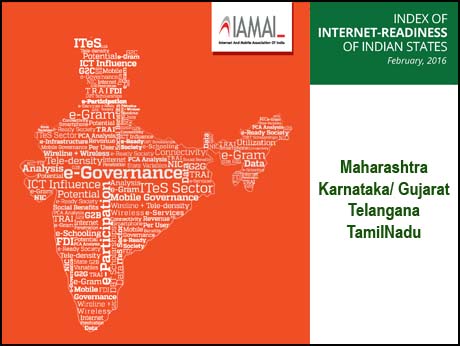
New Delhi, February 10 2016: Maharashtra is India's number one state in terms of overall Internet readiness index, followed by Karnataka, Gujarat, Telengana and Tamil Nadu, according to a report published by the Internet and Mobile Association of India (IAMAI) and Indicus Analytics.
Karnataka and Gujarat are close second and third while Telengana and Tamil Nadu are close fourth and fifth. Incidentally, the bottom four states are all from the Eastern region. The rankings of the 21 large states are given below.
|The report -- ‘Index of Internet Readiness of Indian States’ -- find that among the smaller states, Delhi has emerged as the topmost state in terms of Internet readiness index, followed by Puducherry and Goa. Even in the smaller states, the northeastern States do not figure among the top three. Therefore, much more needs to be done in the form of investment and infrastructure development in the region.
Among the Union Territories, Chandigarh is ranked top in terms of Internet readiness index.
Internet Readiness index is a composite index of five components, i.e., e-Infrastructure index, e-Participation index, IT-Services and e-Governance index. The performance of the states based on internet readiness index depends on several factors. The driving factors influencing Internet readiness index of each state varies from one another. For instance, in Maharashtra, though e-infrastructure is relatively low compared to Kerala, Karnataka, Gujarat etc, yet the state surpasses others in all other components making it the best e-Ready society. In case of Karnataka, participation of citizen in ICT environment is lower than Kerala and Gujarat, yet on account of the high contribution of IT to overall economy and success in e-government initiatives makes the state the second most e-Ready environment in the county. Madhya Pradesh, though having a high rating in terms of participation, ranks low in all other components. Nevertheless, all the four components have equal significance in the Internet readiness index model.
The report highlights the performance of the states regarding different measures of Internet readiness index. Given the rapid advancement in e-services and e-commerce, it is essential to understand the strengths and weaknesses of the states. While this would help the business and governments to leverage the strength, policy measures can also be taken where improvements are required.
Selection of the categories (and the parameters within each category) was based on the broader understanding of Internet readiness of citizens, whereas Internet readiness encapsulates the spread and extent of the digital sector in different aspects of the socio-economic realities of each state. Thus, Internet readiness in this study is not limited to how industry friendly each state is for investment in the IT sector, but aims to give a more holistic picture of the digital ecosphere that presently exists in the states. This stems from the understanding that only an organic linkage between the digital world and the real world can lead to the development and wellbeing that digitalization promises to deliver.
The key internet using parameters, which have been used in this report, are: Mobile subscribers per person above 15 years of age; Share of private players in internet service providers; Percentage of households using computer/ laptop with internet connection; No. of e-transactions in Utility Bill payments per lakh person above 15 years; No. of e-transactions in Business to Citizen (B2C) Services per lakh person above 15 years; No. of e-transactions in Informational Services per lakh person above 15 years; No. of e-transactions in Statutory and Non-Statutory services per lakh person above 15 years, among others.
That is why it this report is different from the traditional e-readiness reports, which had no internet parameters. A different report using the internet parameter was necessary to understand where states stand in terms of Internet readiness, rather than general e-readiness. An annual study, this study would include the parameter of measuring the startup ecosystem of states next year.